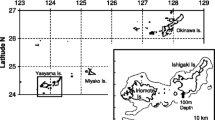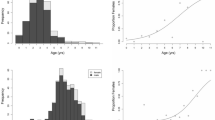Abstract
We studied age, growth, and sexual development in the early life intervals of the self-fertilizing mangrove killi-fish, Rivulus marmoratus. Newly hatched (day 0) individuals had sagittal otoliths of 60 μm radius, with about 30 increments. Sequential sampling until about day 60 after hatching yielded otoliths with the number of increments outside the 60 μm radius equal to the daily age of the fish. Alizarin complexone marking of otoliths also confirmed the increments were daily, and demonstrated the applicability of this technique to field studies for capture-mark-recapture, or age and growth estimates. Individuals fed a restricted amount of food formed fewer daily otolith growth increments than fish fed to satiation each day. Using histological analysis for identifying gonad morphogenesis, we found no correlation between gonadal development and external appearance (caudal ocellus, orange fin colouration) in young fish of known ages. The caudal ocellus was not present until 9 mm total length, and developed thereafter. Of 136 individuals examined, fish less than 17.2 mm total length (TL, n = 124) were females. Testicular tissue first appeared among individuals 17–18 mm TL (n = 3), while some individuals greater than 18 mm TL (n = 8) were functional hermaphrodites. The single male in our study was relatively of small body size (9.6 mm, day 37) with a distinct caudal ocellus, indicating that it is presumably a primary male.
Similar content being viewed by others
References cited
Abel, D.C., C.C. Koenig & W.P. Davis. 1987. Emersion in the mangrove forest fish Rivulus marmoratus: a unique response to hydrogen sulfide. Env. Biol. Fish. 18: 67–72.
Ali, M.A., M.A. Klyne, E.H. Park & S.H. Lee. 1988. Structural changes in retinal pigmented epithelium of Rivulus marmoratus Poey embryos during development. Anatom. Embryol. 177: 451–458.
Campana, S.E. 1983. Feeding periodicity and the production of daily growth increments in otoliths of steelhead trout (Salmo gairdneri) and starry flounder (Paralichthys stellatus). Can. J. Zool. 61: 1591–1597.
Campana, S.E. & J.D. Neilson. 1985. Microstructure of fish otoliths. Can. J. Fish. Aquat. Sci. 42: 1014–1032.
Cole, K.S. & D.L.G. Noakes. 1997. Gonadal development and sexual allocation in mangrove killifish, Rivulus marmoratus (Pisces: Atherinomorpha). Copeia 1997: 596–600.
Couch, J.A. 1995. Invading and metastasizing cardiac hemangioendothelial neoplasms in a cohort of the fish Rivulus marmoratus: unusually high prevalence, histopathology, and possible etiologies. Cancer Res. 55: 2438–2447.
Davis, W.P. 1988. Reproductive and developmental responses in the self-fertilizing fish, Rivulus marmoratus, induced by the plasticizer, di-n-butylphthalate. Env. Biol. Fish. 21: 81–90.
Davis, W.P., D.S. Taylor & B.J. Turner. 1990. Field observations of the ecology and habits of mangrove rivulus (Rivulus marmoratus) in Belize and Florida. Ichthyol. Explor. Freshwater 1: 123–134.
Green, R.F. & D.L.G. Noakes. 1995. Is a little bit of sex as good as a lot? J. Theoret. Biol. 174: 87–96.
Harrington Jr., R.W. 1961. Oviparous hermaphroditic fish with internal self-fertilization. Science 134: 1749–1750.
Harrington Jr., R.W. 1967. Environmentally controlled induction of primary male gonochrists from eggs of the self-fertilizing hermaphroditic fish, Rivulus marmoratus Poey. Biol. Bull. 132: 174–199.
Harrington Jr., R.W. 1968. Delimitation of the thermolabile phenocritical period of sex determination and differentiation in the ontogeny of the normally hermaphroditic fish Rivulus marmoratus Poey. Physiological Zoology 41: 447–460.
Harrington Jr., R.W. 1971. How ecological and genetic factors interact to determine when self-fertilizing hermaphrodites of Rivulus marmoratus change into functional secondary males, with reappraisal of the models of intersexuality among fishes. Copeia 1971: 339–432.
Harrington Jr., R.W. 1975. Sex determination and differentiation among uniparental homozygotes of the hermaphroditic fish Rivulus marmoratus (Cyprinodontidae: Atheriniformes). pp. 249–262. In: R. Reinboth (ed.) Intersexuality in the Animal Kingdom, Springer Verlag, New York.
Harrington Jr., R.W. & K.D. Kallman. 1968. The homozygosity of clones of the self-fertilizing hermaphroditic fish, Rivulus marmoratus Poey (Cyprinodontidae, Atheriniformes). Amer. Nat. 102: 337–343.
Harrington Jr., R.W. & L.R. Rivas. 1958. The discovery in Florida of the cyprinodont fish, Rivulus marmoratus, with a redescription and ecological notes. Copeia 1958: 125–130.
Keene, J.L., D.L.G. Noakes, R.D. Moccia & C.G. Soto. 1998. The efficiency of clove oil as an anaesthetic for rainbow trout, Oncorhynchus mykiss (Walbaum). Aquacult. Res. 29: 89–101.
King, J.A.C., D.C. Abel, D.R. Dibona & J.L.C. Ashcraft. 1988. Effects of salinity on chloride cell ultrastructure and density in the euryhaline cyprinodontid fish Rivulus marmoratus. Amer. Zool. 28: 100A.
King, J.A.C., D.C. Abel & D.R. Dibona. 1989. Effects of salinity on chloride cells in the euryhaline cyprinodontid fish Rivulus marmoratus. Cell Tiss. Res. 257: 367–378.
Koenig, C.C. & M.P. Chasar. 1984. Usefulness of the hermaphroditic marine fish, Rinlus marmoratus, in carcinogenicity testing. Nat. Cancer Inst. Monogr. 65: 15–33.
Lin, H.C. & W.A. Dunson. 1993. The effect of salinity on the acute toxicity of cadmium to the tropical, estuarine, hermaphroditic fish, Rivulus marmoratus: a comparison of cadmium, copper, and zinc tolerance with Fundulus heteroclitus. Arch. Env. Contami. Toxicol. 25: 41–47.
Lubinski, B.A., W.P. Davis, D.S. Taylor & B.J. Turner. 1995. Outcrossing in a natural population of a self-fertilizing hermaphroditic fish. J. Hered. 86: 469–473.
Masuda, R. & K. Tsukamoto. 1998. The ontogeny of schooling behaviour in the striped jack. J. Fish Biol. 52: 483–493.
Masuda, R., T. Takeuchi, K. Tsukamoto, Y. Ishizaki, M. Kanematsu & K. Imaizumi. 1998. Critical involvement of dietary docosahexaenoic acid in the ontogeny of schooling behavior in the yellowtail. J. Fish Biol. 53: 471–484.
Molony, B.W. 1996. Episodes of starvation are recorded in the otoliths of juvenile Ambassis vachelli (Chandidae), a tropical estuarine fish. Mar. Biol. 125: 439–446.
Mugiya, Y. 1987. Effects of photoperiods on the formation of otolith increments in the embryonic and larval rainbow trout Salmo gairdneri. Bull. Japan. Soc. Sci. Fish. 53: 1979–1984.
Noakes, D.L.G. & J.-G.J. Godin. 1988. Ontogeny of behavior and concurrent developmental changes in sensory systems in teleost fishes. pp. 345–395. In: W.S. Hoar & D.J. Randall (ed.) Fish Physiology, Volume XI, Part B, Academic Press, San Diego.
Park, E.H. & D.S. Kim. 1984. Hepatocarcinogenicity of diethylnitrosamine to the self-fertilizing hermaphroditic fish Rivulus marmoratus (Teleostomi: Cyprinodontidae). J. Nat. Cancer Inst. (Japan) 73: 871–876.
Park, E.H. & S.H. Lee. 1988. Scale growth and squamation chronology for the laboratory-reared hermaphroditic fish Rivulus marmoratus (Cyprinodontidae). Japan. J. Ichthyol. 34: 476–482.
Park, E.H., H.H. Chang, W.N. Joo, H.S. Chung & H.S. Kwak. 1994. Assessment of the estuarine hermaphroditic fish Rivulus marmoratus as a useful euryhaline species for acute toxicity tests as shown using cadmium. Can. J. Fish. Aquat. Sci. 51: 280–285.
Payan, P., G. Borelli, G. Boeuf & N. Mayer-Gostan. 1998. Relationship between otolith and somatic growth: consequence of starvation on acid-base balance in plasma and endolymph in the rainbow trout Oncorhynchus mykiss. Fish Physiol. Biochem. 19: 35–41.
Radtke, R.L. & J.M. Dean. 1982. Increment formation in the otoliths of embryos, larvae, and juveniles of the mummichog, Fundulus heteroclitus. U.S. Fish. Bull. 80: 201–215.
Ritchie, S.A. & W.P. Davis. 1986. Evidence for embryonic diapause in Rivulus marmoratus: laboratory and field observations. J. Amer. Killifish Ass. 19: 103–108.
Sakakura, Y. & K. Tsukamoto. 1997. Age composition in the schools of juvenile yellowtail, Seriola quinqueradiata, associated with drifting seaweeds in the East China Sea. Fish. Sci. 63: 37–41.
Sakakura, Y. & K. Tsukamoto. 1999. Ontogeny of aggressive behaviour in schools of yellowtail Seriola quinqueradiata. Env. Biol. Fish. 56: 231–242.
Secor, D.H., J.M. Dean & S.E. Campana (ed.). 1995. Recent developments in fish otolith research. University of South Carolina Press, Columbia. 735 pp.
Sokal, R.R. & F.J. Rohlf. 1995. Analysis of frequencies. pp. 685–793. In: R.R. Sokal & F.J. Rohlf (ed.) Biometry, W.H. Freeman and Company, New York.
Soto, C.G., J.F. Leatherland & D.L.G. Noakes. 1992. Gonadal histology in the self-fertilizing hermaphroditic fish Rivulus marmoratus (Pisces, Cyprinodontidae). Can. J. Zool. 70: 2338–2347.
Soto, C.G. & D.L.G. Noakes. 1994. Colouration and gender in the hermaphroditic fish Rivulus marmoratus Poey (Teleostei: Rivulidae). Ichthyol. Explor. Freshwaters 5: 79–90.
Swain, D.P. & C.C. Lindsey. 1986a. Influence of reproductive history of parents on meristic variation in offspring in the cyprinodont fish Rivulus marmoratus. Can. J. Zool. 64: 1456–1459.
Swain, D.P. & C.C. Lindsey. 1986b. Meristic variation in a clone of the cyprinodont fish Rivulus marmoratus related to temperature history of the parents and of the embryos. Can. J. Zool. 64: 1444–1455.
Taylor, D.S. 1992. Diet of the killifish Rivulus marmoratus collected from land crab burrows, with further ecological notes. Env. Biol. Fish. 33: 389–393.
Taylor, D.S., W.P. Davis & B.J. Turner. 1995. Rivulus marmoratus: ecology of distributional patterns in Florida and the Central Indian River Lagoon. Bull. Mar. Sci. 57: 202–207.
Turner, B.J., J.F. Elders, Jr. & T.F. Laughlin. 1991. Repetitive DNA sequences and the divergence of fish populations: some hopeful beginnings. J. Fish Biol. 39: 131–142.
Turner, B.J., W.P. Davis & D.S. Taylor. 1992a. Abundant males in populations of a selfing hermaphrodite fish, Rivulus marmoratus, from some Belize cays. J. Fish Biol. 40: 307–310.
Turner, B.J., J.F. Elder, Jr., T.F. Laughlin, W.P. Davis & D.S. Taylor. 1992b. Extreme clonal diversity and divergence in populations of a selfing hermaphroditic fish. Proc. Nat. Acad. Sci. 89: 10643–10647.
Tsukamoto, K. 1985. Mass-marking of ayu eggs and larvae by tetracycline-tagging of otoliths. Bull. Japan. Soc. Sci. Fish. 51: 903–911.
Tsukamoto, K. 1988. Otolith tagging of ayu embryo with fluorescent substances. Bull. Japan. Soc. Sci. Fish. 54: 1289–1295.
Tsukamoto, K. & T. Kajihara. 1987. Age determination of ayu with otolith. Bull. Japan. Soc. Sci. Fish. 53: 1985–1997.
Tsukamoto, K., Y. Seki, T. Oba, M. Oya & M. Iwahashi. 1989a. Application of otolith to migration study of salmonids. Physiol. Ecol. Japan 1: 119–140.
Tsukamoto, K., H. Kuwada, J. Hirokawa, M. Oya, S. Sekiya, H. Fujimoto & K. Imaizumi. 1989b. Size-dependent mortality of red sea bream, Pagrus major, juveniles released with fluorescent otolith-tags in News Bay, Japan. J. Fish Biol. 35: 59–69.
Tzeng, W.N. & S.Y. Yu. 1992. Effects of starvation on the formation of daily growth increments in the otoliths of milkfish, Chanos chanos (Forssk al), larvae. J. Fish Biol. 40: 39–48.
Umezawa, A. & K. Tsukamoto. 1991. Factors influencing otolith increment formation in Japanese eel, Anguilla japonica T&S., elvers. J. Fish Biol. 39: 211–223.
Warner, R.R. 1978. The evolution of hermaphroditism and unisexuality in aquatic and terrestrial vertebrates. pp. 77–101. In: E.S. Reese & F.J. Lighter (ed.) Contrasts in Behavior, Wiley, New York.
Author information
Authors and Affiliations
Rights and permissions
About this article
Cite this article
Sakakura, Y., Noakes, D.L.G. Age, Growth, and Sexual Development in the Self-fertilizing Hermaphroditic Fish Rivulus marmoratus. Environmental Biology of Fishes 59, 309–317 (2000). https://doi.org/10.1023/A:1007627411492
Issue Date:
DOI: https://doi.org/10.1023/A:1007627411492




